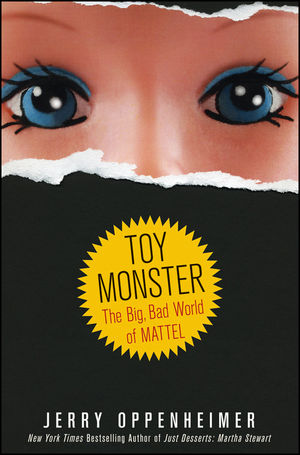I get terrified going through a toy section of a department store… not just because I know I will be under pressure from my children… but mostly because of the dreaded PINK aisle. So much pink… I never allowed my daughter to own a Barbie, or a Bratz. However, my son did become an avid collector of Mattel's Hot Wheels.
In that way we did our small bit to prop up an empire built by some unsavoury characters who are exposed in this salacious read from Jerry Oppenheimer, biographer of celebrity.
 Perhaps because Oppenheimer has written about American icons such as Martha Stewart, the Clintons and the Kennedys, he feels the need to compete with the gossip rags in providing sexy detail and eliciting an ooh-ahh response.
Perhaps because Oppenheimer has written about American icons such as Martha Stewart, the Clintons and the Kennedys, he feels the need to compete with the gossip rags in providing sexy detail and eliciting an ooh-ahh response.
However, aside from the sensationalism, there is enough dirt here to suggest that those behind the Mattel toy empire were a grubby lot.
Barbie was modelled on the favourite women of millionaire toy designer Jack Ryan. He kept his real-life female companions in the shape he had become accustomed to by forcing them to have plastic surgery and taking diet pills; and one even died of anorexia. In real life Barbie would be more than two metres tall and so anatomically imbalanced she would fall flat on her face.
Barbie was the first adult doll for girls (and boys) and has been delighting children of all ages for more than 50 years. Unfortunately she is also pretty controversial, with feminists and health professionals criticising the way she has influenced girls in terms of fashion consumerism, passivity and eating disorders.
When discussing this Barbie brainwashing with a friend, she fiercely denied any negative impact on herself or her children. However, when I asked her "When did you first become interested in fashion?" She admitted that it was while she was dressing her Barbie.
In fact Mattel pioneered some pretty nasty tactics to maximise sales including using psychologists to work out how to groom children as consumers, advertising on TV and focusing on children's programming, introducing the concept of toy accessories, overloading inventories at shops to artificially inflate revenues, not supervising overseas manufacturing resulting in the 2007 lead paint scandal and a massive recall, and finally the Polly Pockets cover-up where the company allegedly paid for the silence of families of children who became dangerously ill from ingesting magnets loose in the doll's clothing.
The Oppenheimer book is an expose of Mattel rather than Barbie, but she is the image of the brand and is tarnished in the process.
What happened to the innocence of play? I read this book while staying near a beach; and as I saw children entertained for hours by sand and waves and rock pools it made me wonder why we seek to complicate their lives with plastic and gadgets and discs and connectivity. My children's rooms are full of things they had to have until they got them.
Is it possible also that the nature of the creator is infused in the objects created? In which case, toy manufacturers have a special responsibility to serve their vulnerable consumers. Perhaps, toys are evidence of the sinful heart of humanity, in need of rescuing. Some garishly-dressed adult dolls certainly seem an indication of that!



















